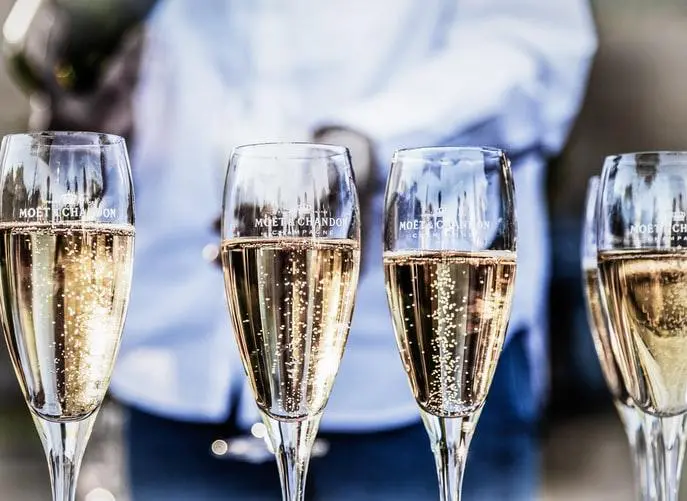Summary of our market study
The French champagne market is estimated at around €2.5 billion in 2023.
In 2020, the champagne market faced significant challenges due to the COVID-19 pandemic. Worldwide volume sales fell by 18%.
In 2024, they reached 300 million 75 cl bottles sold, for a total of €6.4 billion. 57% of sales are exported.
France is the world's leading consumer of champagne, with around 130 million bottles in 2023.
Alcohol consumption in France is in structural decline, with annual per capita consumption of 10.38 liters in 2020. Champagne consumption is moving towards high-end products.
The Champagne appellation is strictly regulated to guarantee product quality and authenticity.
Champagne consumption trends in France
Champagne occupies a special place due to its historical and cultural importance. France will account for 43% of champagne consumption by volume in 20203.
The majority of consumers are aged over 50. Men are more likely to drink champagne than women.
Champagne brut dominates, with over 85% of consumption by volume and value. Rosé and demi-sec variants account for 15% of consumption. The French market is moving upmarket.
Moët & Chandon tops the list of consumer preferences, followed by Nicolas Feuillatte.
The champagne industry faces competition from cheaper sparkling wines, imports of which rose by 50% between 1015 and 2020.
Champagne market players
- LVMH (Moët Hennessy Louis Vuitton): LVMH is a titan of the champagne industry, with a portfolio that includes some of the most prestigious and sought-after brands, Moët & Chandon, Veuve Clicquot, Dom Pérignon, Krug and Ruinart.
- Nicolas Feuillatte: This cooperative brand has made significant inroads into the French market. Founded in 1976, Nicolas Feuillatte has made a name for itself thanks to its accessible luxury positioning.
- Vranken-Pommery Monopole: Another well-established major player.
- Champagne Taittinger: With its family roots and attachment to tradition, Champagne Taittinger is another key player in maintaining the prestige of Champagne.
- Champagne Bollinger: Known for its robust, complex champagnes, Bollinger's iconic status and association with British secret agent James Bond have only enhanced its image of sophistication and art de vivre.
to understand this market
Detailed content of our market study
 Inforamtion
Inforamtion
- Number of pages : 35 pages
- Format : Digital and PDF versions
- Last update :
 Summary and extracts
Summary and extracts
1 Market overview
1.1 Definition and scope of the study
Champagne is a product made from grapes grown in the Champagne region of France. the grapes used are very specific like Pinot Noir, Pinot Meunier and Chardonnay. These grapes are fermented to obtain a wine that contains about 9% alcohol by volume. Champagne belongs to the category of sparkling wines and is strictly regulated by the Comité Champagne de France.
Various countries may produce sparkling wines similar to champagne, but none can be sold or labeled as champagne. All champagne is sparkling wine, but not all sparkling wine is champagne, as grapes grown under the rules of the appellation are only allowed to make champagne.
France is historically the world's leading consumer of champagne; nevertheless, for the first time in 2018, international Champagne exports exceeded shipments to the French territory. However, the health crisis had an immediate effect on champagne sales in France and internationally, which saw a sharp decline in volume in 2020.
All our studies are available online in PDF format
Take a look at an example of our research on another market!
 Choosing this study means :
Choosing this study means :
Access to more than 35 hours of work
Our studies are the result of over 35 hours of research and analysis. Using our studies allows you to devote more time and added value to your projects.
Benefit from 6 years' experience and over 1,500 industry reports already produced
Our expertise enables us to produce comprehensive studies in all sectors, including niche and emerging markets.
Our know-how and methodology enable us to produce reports that offer unique value for money.
Access to several thousand articles and paid-for data
Businesscoot has access to all the paid economic press as well as exclusive databases to carry out its market research (over 30,000 articles and private sources).
To enhance our research, our analysts also use web indicators (semrush, trends, etc.) to identify market trends and company strategies. (Consult our paying sources)
Guaranteed support after your purchase
A team dedicated to after-sales service, to guarantee you a high level of satisfaction. +44 238 097 0676
A digital format designed for our users
Not only do you have access to a PDF, but also to a digital version designed for our customers. This version gives you access to sources, data in Excel format and graphics. The content of the study can therefore be easily retrieved and adapted for your specific needs.
 Our offers :
Our offers :
the champagne market | France
- What are the figures on the size and growth of the market?
- What is driving the growth of the market and its evolution?
- What is the positioning of companies in the value chain?
- Data from several dozen databases
Pack 5 études (-25%) France
- 5 études au prix de 74 €HT par étude à choisir parmi nos 1200 titres sur le catalogue
- Conservez -25% sur les études supplémentaires achetées
- Choisissez le remboursement des crédits non consommés au terme des 12 mois (durée du pack)
Consultez notre catalogue d’études sectorielles


















